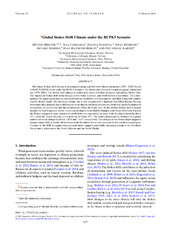Global Stokes drift climate under the RCP8.5 scenario
Breivik, Øyvind; Carrasco, Ana; Staneva, Joanna; Behrens, Arno; Semedo, Alvaro; Bidlot, Jean-Raymond; Aarnes, Ole Johan
Peer reviewed, Journal article
Published version

Åpne
Permanent lenke
https://hdl.handle.net/1956/22591Utgivelsesdato
2019Metadata
Vis full innførselSamlinger
Originalversjon
https://doi.org/10.1175/jcli-d-18-0435.1Sammendrag
The future Stokes drift climate is investigated using a global wave climate projection (2071–2100) forced with EC-EARTH winds under the RCP8.5 scenario. The future climate run is compared against a historical run (1976–2005). The Stokes drift climate is analyzed in terms of Stokes transport and surface Stokes drift. The impact on Stokes drift from changes to the wind, wind sea, and swell climate is identified. The consequences for upper-ocean mixing and circulation are studied by investigating the turbulent Langmuir number and the Stokes depth. The historical climate run is also compared to a hindcast with ERA-Interim forcing. Systematic discrepancies due to differences in resolution and model physics are identified, but no fundamental weaknesses are uncovered that should adversely affect the future run. As the surface Stokes drift is largely dictated by high-frequency waves, it is to a great degree controlled by changes to the local wind field, whereas the Stokes transport is more sensitive to swell. Both are expected to increase in the Southern Ocean by about 15%, while the North Atlantic sees a decrease of about 10%. The Stokes depth and the turbulent Langmuir number are set to change by about ±20% and ±10%, respectively. The changes to the Stokes depth suggest a deeper impact of the Coriolis–Stokes force in the Southern Ocean and a decrease in the northern extratropics. Changes to the KPP Langmuir-enhancement factor suggests potentially increased mixing in the Southern Ocean and a reduction in the North Atlantic and the North Pacific.